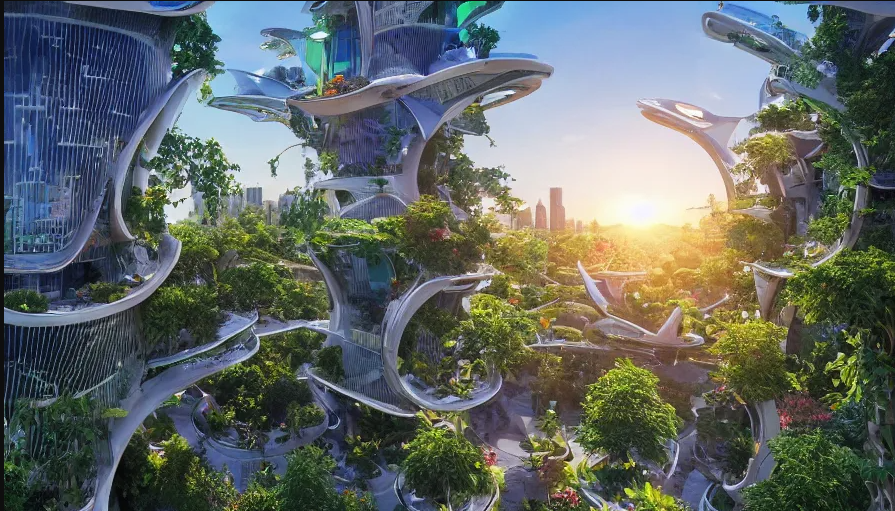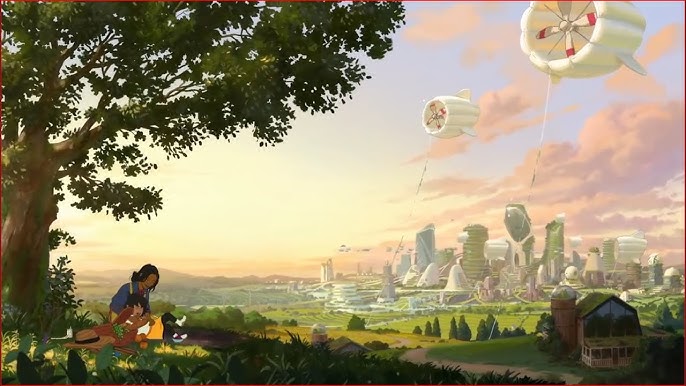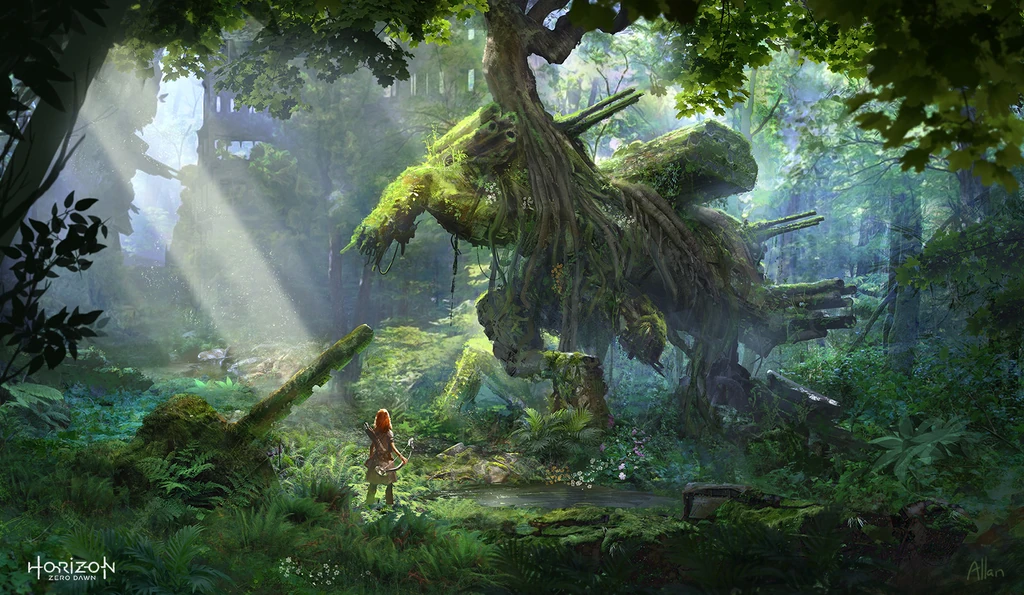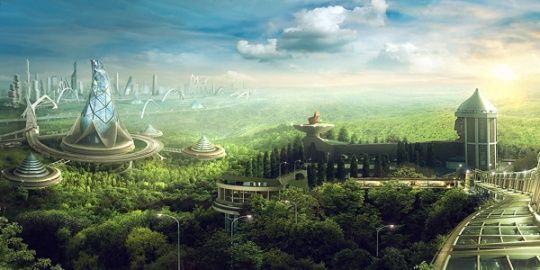We’ll start this with a pretty picture and idyllic feeling. All you have to do is play the video below to be filled with a sense of pastoral, green tech and communal wonder. The fact that it’s a commercial for a factory farmed, mass market yogurt company (Chobani) is probably smashing the irony button just a little –too– hard. But that’s the thing with Solarpunk, it’s filled with contradictions.
Now that we’re past that…WHEW!
Trying to nail down Solarpunk as a genre is… a MESS. There are so many things going on (sometimes conflicting) that it’s hard to figure out where to begin. Solarpunk isn’t just a literary genre. It’s a design/architectural/urban planning philosophy, a spiritual way of looking at how we interact with the Earth, a political point of view. And for my purposes here – a REALLY cool narrative construct. With all that said, the central question raises it’s ugly head.
“What the hell is it?”
Remember when I said this was a mess? Yeah… Taking a hint of wisdom from the all-knowing Saint Deadpool, “It’s not pretty. ‘It’s like two hobos…” Uhhh… Nevermind. Too graphic.
Anyway… To start with, I’m not going to try and cover all the bases. I’m not qualified to talk about most of them. There is a concise but thorough description of Solarpunk as an overall concept, HERE. I’ve also put a couple of links at the end of this post. What I want to talk about are some of the challenges I’ve heard talked about when trying to tackle Solarpunk from a storytelling perspective.

One of the core issues in dealing with Solarpunk is that it’s often viewed as utopian. A Solarpunk world has found itself in balance. That’s a big problem narratively. Where’s the conflict?
There are a couple of devices that come to my mind in addressing this problem. One is the idea that utopias don’t pop out of the holes in the ground like Dwarves, fully formed. So, the first concept is that our characters and our story haven’t reached utopia – yet. A quote I’ve used to describe the Æsterverse setting is:
‘There is a golden age right around the corner, if we are bright enough, brave enough and bold enough to seize it.”
The second idea is that of utopia in decay. Ages-old technology is failing, risking the destruction of everything the characters know.
Neither of these narrative constructs are new by any stretch of the imagination. But when I think of trying to do something with a setting as exciting as Solarpunk, these have some serious ‘teeth’ to them. With them I can really feel the heartbreak, hope and fear of having such a shining world as Solarpunk either just out of reach or slipping from my grasp.
On Hope – Just because something is hopeful doesn’t mean there is no conflict. Wars, murder, and many of the other horrifically normal human activities can take place along the road toward utopia. In “The Return of the King”, we never see the “Age of the King” Gandalf talks about after Sauron is defeated. But the path the characters have trod to reach that bright future is littered with carnage. In “The Last Jedi” and “Rogue One”, hope is all that stands between the characters and the abyss. It drives them to make enormous sacrifices, and in the case of ‘Rogue One’, to be utterly ruthless revolutionaries.
Solarpunk vs. Cyberpunk – Solarpunk as a literary genre is said to be a child of, or reaction to Cyberpunk. I can see that. They both live firmly in the science fiction spectrum (at least in my opinion). Where Cyberpunk is dystopian, harsh, futurism, Solarpunk is hopeful futurism. In Cyberpunk we often see people live under crippling corporate authoritarianism, their only escape in drugs or virtual reality. That stands in stark contrast to a world where technology is built to work with nature, not against it. Now a story about a Solarpunk cyborg, that’s breaking some interesting ground.
Working with Nature instead of dominating it – In Solarpunk we often see buildings and technology that not only blend with the landscape, but take inspiration from it. This seems to be a central piece of Solarpunk. Much of the art that’s labeled ‘Solarpunk’ features buildings that are festooned with greenery, in some cases their architecture mimics that of the natural world, buildings shaped like flowers, etc. This is a place where Solarpunk really gets infused by architecture and urban planning. What happens when you have a city that’s built around a river whose power is generated by the river’s natural flow? Or one built on a mountainside where air currents up and down the slope run turbines? There are loads of different ideas for how technology can work with nature instead of taking from it.
Arcologies – I grew up in Arizona where an amazing architectural experiment called Arcosanti has been in work for nearly fifty years. The architect behind it all, Paolo Soleri, is the man who invented the term ‘Arcology‘. We see arcologies all over the place in cyberpunk and other science fiction, but for me arcologies are a hand in glove fit with Solarpunk. Some of Soleri’s original intentions behind arcologies are an exact match to Solarpunk’s themes. “We’re here to be a part of the landscape, not in spite of it.” This feels like a core theme in Solarpunk. And arcologies are just really cool conceptually, very fertile ground for storytelling.
Societies attuned to the natural world – Many societies in sci-fi and fantasy see the world around them as filled with ‘natural resources,’ i.e. something to be exploited. In creating a narrative where society sees themselves as bound to the natural world, instead of in charge of it, I feel we take a huge jump in a different direction. Yes, we already have those societies in the world – Native American, First Nations and Indigenous Peoples. They have their own unique and vibrant histories and stories to tell. Solarpunk is fiction, it can create its own societies that are in tune with the natural world without having to infringe on the REAL history and stories of Indigenous cultures. If we have an industrial society that has come to a realization that it must live in harmony with nature due to some cataclysm, or even a cultural awakening, I think that’s a really cool concept to build a story around. It’s a ‘return to nature’ from technological dependency. That’s a conflict in itself when compared to living in a cultural continuum that has always been tied to the natural world. And that can happen without the necessity of a ‘fall’. We always see societies simplifying after some terrible thing has happened. Solarpunk says it doesn’t have to be that way.
A ruined world remade – One of my all time favorite video games is Horizon Zero Dawn. Sorry for any spoilers for those who haven’t played it. I’ll try and keep them to a minimum. In Horizon Zero Dawn, the apocalypse is long past and a new world has grown up in the ruins populated with mechanical creatures, many which are analogues of dinosaurs. The setting is what I would call a ‘version’ of Solarpunk. There is high-tech, but it’s not under the direct control of the characters. This creates a question. Is Horizon Zero Dawn Solarpunk if the characters don’t control the technology? If it’s not utopian? It’s because of these questions and the conflicts that they represent that make me say Horizon Zero Dawn is Solarpunk. Or maybe it’s becoming Solarpunk. And again, that’s a really cool idea to play with.
This points directly to one of the conundrums of Solarpunk – Intentionality. Most of what I’ve seen described as Solarpunk has to do with societies taking specific steps that lead them to this more balanced world. It’s not random. As I think of some of the ideals behind Solarpunk, I see a tie to spiritual or mental practices that focus on creating intention and making it real. That, in and of itself is a powerful message, and narrative aspect of this genre. It is a distinct counterpoint to the reckless, ‘winner take all’ exploitation that lies at the heart of many other genres. But that can feel oversimplified. I want stories with deep chasms of conflict and uncertainty. Then, when the characters overcome the obstacles, it feels like we’ve all earned it. Solarpunk shouldn’t be all rainbows and sunshine. But those should be visible on the horizon.
That’s my take on Solarpunk. There’s certainly a LOT more that can be said about it. It’s such an amazing concept that there doesn’t seem to be an end to the possibilities of what can be done with it. It’s something I really look forward to playing around with in the future.
Some references I give for Solarpunk:
Horizon Zero Dawn Concept Art – Overgrown Deathbringer
Ruins of Seattle from The Shannara Chronicles





COMMENTs:
0